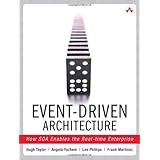
Average Reviews:

(More customer reviews)I had hoped that this book would help me bridge the communications gap between event-driven systems architects like myself and architects that are primarily used to SOA. I also hoped it would help me to work with the our existing SOA infrastructure to realize the benefits of EDA on a wider enterprise level. My hopes were dashed.
The authors fail to inform us how SOA "enables" the "real-time enterprise". In fact they admit that SOA is not the best way to implement event-driven architectures. Worse, they fail to inform us how EDA can even be implemented on a SOA infrastructure.
The real thesis is that EDA is a valuable and overlooked architectural element. It has been overlooked due to the late emphasis on SOA with it's request-reply model. The authors note that many companies probably already have a SOA in place and promise to inform us how we can implement EDA on top of that. But they don't even try to do this.
The most promising chapter in this regard seems to be "The SOA-EDA Connection". But rather than connect anything the author's present yet another mostly evangelistic overview of EDA in the very beginning. It is noted that "Although simple in concept, the realities of bending the raw Simple Object Access Protocol (SOAP) Web services into a functioning EDA are quite challenging and complex". But no real information is given about how to solve this problem. The authors spend the rest of the chapter discussing how one should design and implement SOA; No mention of EDA or how one is to implement it using an existing SOA infrastructure.
Click Here to see more reviews about: Event-Driven Architecture: How SOA Enables the Real-Time Enterprise
Improving Business Agility with EDAGoing beyond SOA, enterprises can gain even greater agility by implementing event-driven architectures (EDAs) that automatically detect and react to significant business events. However, EDA planning and deployment is complex, and even experienced SOA architects and developers need expert guidance. In Event-Driven Architecture, four leading IT innovators present both the theory of EDA and practical, step-by-step guidance to implementing it successfully. The authors first establish a thorough and workable definition of EDA and explore how EDA can help solve many of today's most difficult business and IT challenges. You'll learn how EDAs work, what they can do today, and what they might be able to do as they mature. You'll learn how to determine whether an EDA approach makes sense in your environment and how to overcome the difficult interoperability and integration issues associated with successful deployment. Finally, the authors present chapter-length case studies demonstrating how both full and partial EDA implementations can deliver exceptional business value. Coverage includesHow SOA and Web services can power event-driven architectures

0 comments:
Post a Comment